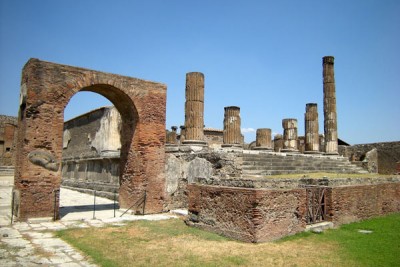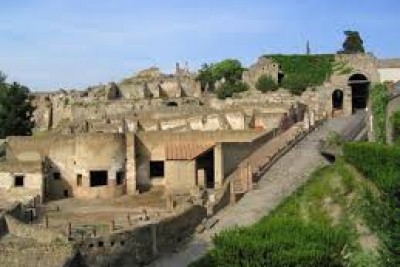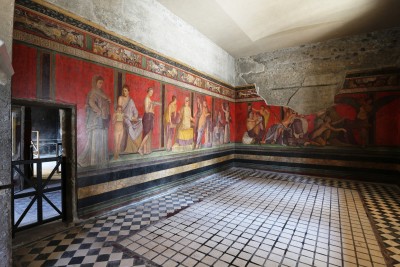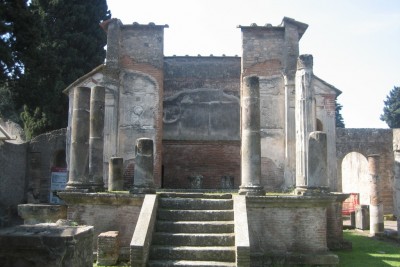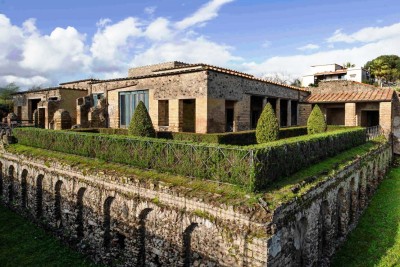Pompeii: Seeing is Believing
An article by Helen E. Parson published on April 2nd, 2005 by the Guelph Mercury (Ontario, Canada)










Pompeii is just a few miles north of the Amalfi Coast, one of most beautiful resort areas in Italy. We suggest you consider staying there in order to visit the ancient Roman town buried by the eruption of Mt Vesuvius. And if you want to avoid the crowds of Positano, Amalfi and Ravello, we recommend you pick Praiano, a less popular and therefore less hectic and more genuine village at the center of the Costiera. That is where many visitors have been staying and using it as a base for their Amalfi Coasting.
Pompeii casts a spell that few other places can match. Most of us know the story: prosperous Roman city buried under volcanic debris when Mount Vesuvius erupted catastrophically in 79 AD; forgotten for centuries; then painstakingly unearthed, largely intact.Visiting Pompeii is somewhat like going on a modern-day house and garden tour.Only this tour transports us back to ancient Rome and to houses and gardens that were frozen in time almost two millennia ago.The people are gone but their places are still there. Have they really been gone that long? Each year about 2.5 million visitors -- from around the world -- come here to wander Pompeii's ancient streets, making this Italy's top tourist attraction. The spell is certainly strong.
 Pompeii's setting is spectacular.The city sits on a plateau of ancient lava just 10 kilometers southeast of Mount Vesuvius, which dominates the view from many points throughout this city.Vesuvius casts part of the spell and seems to demand attention.It is hard to pull your gaze away.In the volcano world, Vesuvius is a dangerous offender and as such, fascinates in its own right. What happened to Pompeii in 79 AD was not a unique event, for Vesuvius has a lengthy and dramatic record.The volcano has been erupting off and on for the past 25,000 years and is currently dormant.Scientists have worked out its history by dating the deposits left by the various eruptions and, in recent times, correlating these findings with written and oral records.Such research has shown that Vesuvius can remain active for centuries at a time and that these active cycles alternate with lengthy periods of repose. An active cycle, however, is not one long continuous eruption but rather a series of shorter periods of action, punctuated by pauses while the volcano regroups.However, nothing is a sure thing as Vesuvius is full of surprises. About all that is predictable is that a lengthy period of repose is likely to end with a major explosive eruption ushering in the next active cycle. The 79 AD eruption was such a cycle.Before that time, Vesuvius had lain dormant for hundreds of years. There was neither knowledge nor memory of what it could do and no one expected trouble.Then on the morning of Aug. 24, Vesuvius roared back to life. Violent vent-clearing explosions were quickly followed by a classic "Plinian" eruption in which a vast column of material blasted straight up, in this case reaching a height of 33 kilometres…Some 300 square kilometres around Vesuvius was completely devastated and all signs of settlement vanished.Pompeii remained buried for the next 1,500 years; knowledge of its existence gradually faded. It wasn't until the 16th century that the city was rediscovered as part of a canal-building enterprise. Excavations began in 1748...Pompeii's wealthy residents lived in large, airy dwellings, the walls decorated with brightly painted murals and the floors covered with intricate mosaics.Others lived much more modestly in less desirable parts of the city. There were bakeries, baths, brothels, sports fields, workshops, theatres, administration buildings, piped water, markets, temples, and even snack bars, 89 in total.It seems the locals liked to have lunch out.The streets were (and still are) paved with basalt cobbles set below the level of the sidewalks because the streets also served as drains.Stepping stones, placed at strategic points and carefully spaced, cleverly allowed pedestrians to cross and carts to still pass. The basalt cobbles are volcanic as are many of the building materials.You can wander at will along the main and side streets, stepping into houses and gardens and business establishments, marvelling at such a rare opportunity to visit ancient Rome. Much was destroyed; what is amazing is how much survived under the ash for all those centuries.The immeasurable importance of these archeological treasures is now widely appreciated and the ongoing work is supported by international foundations as well as by the admission fee paid by visitors.Critically important is the preservation of what has been unearthed. Volcanic ash has protected the buried structures and artifacts. When exposed to the air, however, everything quickly deteriorates.While much remains on site, the most significant artifacts from Pompeii are now displayed in the Museo Archeologico Nazionale in Naples.Since 79 AD, Vesuvius has gone through a number of active cycles. The most recent one began in 1631 and lasted off and on until 1944.Scientists expect that when the volcano next comes back to life, it will do so explosively. All this gives pause for thought as you stand in Pompeii, gazing towards the dramatic outline of Vesuvius against the sky.The volcano sits like a huge sleeping dragon in a sea of development, its pulse and temperature constantly monitored for signs of life…
Pompeii's setting is spectacular.The city sits on a plateau of ancient lava just 10 kilometers southeast of Mount Vesuvius, which dominates the view from many points throughout this city.Vesuvius casts part of the spell and seems to demand attention.It is hard to pull your gaze away.In the volcano world, Vesuvius is a dangerous offender and as such, fascinates in its own right. What happened to Pompeii in 79 AD was not a unique event, for Vesuvius has a lengthy and dramatic record.The volcano has been erupting off and on for the past 25,000 years and is currently dormant.Scientists have worked out its history by dating the deposits left by the various eruptions and, in recent times, correlating these findings with written and oral records.Such research has shown that Vesuvius can remain active for centuries at a time and that these active cycles alternate with lengthy periods of repose. An active cycle, however, is not one long continuous eruption but rather a series of shorter periods of action, punctuated by pauses while the volcano regroups.However, nothing is a sure thing as Vesuvius is full of surprises. About all that is predictable is that a lengthy period of repose is likely to end with a major explosive eruption ushering in the next active cycle. The 79 AD eruption was such a cycle.Before that time, Vesuvius had lain dormant for hundreds of years. There was neither knowledge nor memory of what it could do and no one expected trouble.Then on the morning of Aug. 24, Vesuvius roared back to life. Violent vent-clearing explosions were quickly followed by a classic "Plinian" eruption in which a vast column of material blasted straight up, in this case reaching a height of 33 kilometres…Some 300 square kilometres around Vesuvius was completely devastated and all signs of settlement vanished.Pompeii remained buried for the next 1,500 years; knowledge of its existence gradually faded. It wasn't until the 16th century that the city was rediscovered as part of a canal-building enterprise. Excavations began in 1748...Pompeii's wealthy residents lived in large, airy dwellings, the walls decorated with brightly painted murals and the floors covered with intricate mosaics.Others lived much more modestly in less desirable parts of the city. There were bakeries, baths, brothels, sports fields, workshops, theatres, administration buildings, piped water, markets, temples, and even snack bars, 89 in total.It seems the locals liked to have lunch out.The streets were (and still are) paved with basalt cobbles set below the level of the sidewalks because the streets also served as drains.Stepping stones, placed at strategic points and carefully spaced, cleverly allowed pedestrians to cross and carts to still pass. The basalt cobbles are volcanic as are many of the building materials.You can wander at will along the main and side streets, stepping into houses and gardens and business establishments, marvelling at such a rare opportunity to visit ancient Rome. Much was destroyed; what is amazing is how much survived under the ash for all those centuries.The immeasurable importance of these archeological treasures is now widely appreciated and the ongoing work is supported by international foundations as well as by the admission fee paid by visitors.Critically important is the preservation of what has been unearthed. Volcanic ash has protected the buried structures and artifacts. When exposed to the air, however, everything quickly deteriorates.While much remains on site, the most significant artifacts from Pompeii are now displayed in the Museo Archeologico Nazionale in Naples.Since 79 AD, Vesuvius has gone through a number of active cycles. The most recent one began in 1631 and lasted off and on until 1944.Scientists expect that when the volcano next comes back to life, it will do so explosively. All this gives pause for thought as you stand in Pompeii, gazing towards the dramatic outline of Vesuvius against the sky.The volcano sits like a huge sleeping dragon in a sea of development, its pulse and temperature constantly monitored for signs of life…
This article by Helen E. Parson was published on April 2nd, 2005 by the Guelph Mercury (Ontario, Canada)

